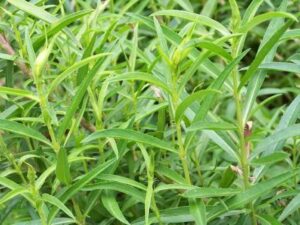 Growing organic tarragon is essential if, like me, you love roast chicken with cream and tarragon, fish baked in fresh herbs, or salads flavoured with fresh herbs. Here are some steps to help you grow organic tarragon, particularly in hot climates like here in the Hautes Corbieres. Here is a quick Growing Organic tarragon guide that covers most things you need to know.
Growing organic tarragon is essential if, like me, you love roast chicken with cream and tarragon, fish baked in fresh herbs, or salads flavoured with fresh herbs. Here are some steps to help you grow organic tarragon, particularly in hot climates like here in the Hautes Corbieres. Here is a quick Growing Organic tarragon guide that covers most things you need to know.
-
Choose a suitable location: Tarragon thrives in moderate sun, so select a location in your garden that receives at least ‘0- hours of direct sunlight per day preferebaly in the morning to avoid the burning heat of a Summer’s afternoon. Ensure the soil is well-drained. I grow my mother plants in half barrels with stones in the bottom.
-
Obtain organic tarragon plants not seeds: You can find organic tarragon plants and useless seeds from local nurseries, garden centres, or reputable online suppliers. Look for certified organic options to ensure they are free from synthetic pesticides or chemicals. Do not expect much the first year, the key objective the first year is to establish a good root base; so that it keeps coming back.
-
Prepare the soil: Tarragon prefers fertile, loamy soil. Before planting, enrich the soil with organic matter such as compost or well-rotted manure. This helps improve soil structure, fertility, and drainage.
-
Planting tarragon:For tarragon plants, dig a hole slightly larger than the root ball and place the plant in the hole. Backfill with soil, gently firming it around the plant. Space multiple plants around 18-24 inches apart.
-
Watering: Tarragon prefers moderate watering. Water the plants regularly, providing enough moisture to keep the soil evenly moist but not waterlogged. Avoid overwatering, as tarragon can be susceptible to root rot. That is why drainage is important.
-
Mulching: Apply a layer of organic mulch around the plants to help conserve moisture, suppress weeds, and regulate soil temperature. Organic mulches, such as straw or wood chips, are good options in the opinion of the experts, personally I use weeds that I have pulled out from other parts of the garden.
-
Organic fertilization: Use organic fertilizers, such as compost or well-rotted manure, to nourish the plants. I pop these on the surface of the soi in the Winter while the plant is dormant.
-
Weed control: Regularly remove weeds around the tarragon plants by hand to prevent competition for nutrients and water.
-
Pruning: Trim the tarragon plants regularly to encourage bushier growth and to prevent them from becoming leggy. Harvesting the leaves frequently also promotes healthy growth. Tarragon keeps it’s flavour if dried for around a lont or tow, bit nothing is better in my view than fresh tarragon.
-
Pest and disease management: Monitor your tarragon plants for pests like aphids or mites. Use organic pest control methods such as spraying neem oil or insecticidal soap to manage infestations. Proper spacing, good airflow, and avoiding overwatering can help prevent fungal diseases.
-
Harvesting: You can start harvesting tarragon leaves when the plants have reached a height of 12-18 inches. Snip off the topmost leaves, leaving some behind to ensure the plant’s vitality. Harvesting regularly will encourage new growth.
-
Reproduction. The only way to reproduce tarragon is to lift the plant in Spring and gently separate off some of the new shoots, pop into rich spoil, or a mix using a growth medium like Orgasyl, and replant when they start to grow. Do not waste your money on seeds, they give tasteless Russian tarragon.
By following these organic gardening practices, you can successfully grow organic tarragon without the use of synthetic pesticides or chemicals. Enjoy the fresh, aromatic flavour of your homegrown organic tarragon in your culinary creations!
Here is the RHS Growing Tarragon page for further advice
